- ABAP Snippets
- Top SAP Courses
- Top SAP Books
SAP and ABAP Free Tutorials

Account assignment in SAP Purchasing (MM) – FAQ

This note provides answers to frequently asked questions regarding account assignment in purchasing documents. This post is based on Snote 496082.
Table of Contents
FAQ: Account Assignement in SAP Purchasing
Account assignement : g/l account for a sales order.
Question: Why is the G/L account for a sales order with nonvaluated individual sales order stock different from the account with valuated indivi dual sales order stock?
Answer: See Note 458270.
Multiple Account Assignment in Purchasing
Question: Can you create several assets at the same time in the new purchasing transactions?
Answer: You can create several assets at the same time. However, you must first ensure that at least as many account assignment lines have bee n created as the number of assets that you want to create. You can do this very easily using the copy function.
G/L Account is not saved if switch to a material group
Question: You create a purchase order with account assignment using transaction ME22. You enter a material group, from which a G/L account is de termined using the valuation class. If you then switch to a material group that does not determine a G/L account via the valuation class, the system deletes the previous G/L account and prompts you to enter a G/L account. If you cancel the account assignment screen and change the material group back on the item detail screen, the previously determined G/L account is not determined again. Why is this ?
Answer: Unfortunately, this system behavior cannot be changed. First, enter any G/L account, so that the item is valid. If you then switch to the old material group again, the system also determines the correct G/L account again.
Entering the same account assignments for different items
Question: Is there an easy way of entering the same account assignments for different items in the new EnjoySAP transactions?
Answer: Ensure that Note 315676 has been implemented in your system and follow the procedure described there
Repeat account assignment function not work in the new EnjoySAP
Question: Why does the repeat acc. assignment function not work in the new EnjoySAP transactions when you create new account assignments in multiple acc. assign. ?
Solution: Use the copy function in multiple acc. assignment to create identical account assignment lines. You can use the repeat account assi gnment function to create similar account assignments for different items with the same account assignment category. To do this, proce ed as described in the answer to question 4.
Issue message KI 161 “Cost center &/& does n ot exist on &
Question: When you change the account assignment of an existing purchase order, why does the system issue message KI 161 “Cost center &/& does n ot exist on &” ? The same phenomenon occurs for other account assignment objects (for example, profit center).
Solution: Refer to Note 193371.
Can you create assets from the single account assignment screen?
Solution: Assets can only be created from the multiple account assignment screen (“Account assignment” tab). You can switch between single account assignment and multiple account assignment on the “Account assignment” tab page by clicking the icon above on the left.
Why does the system not display an account assignment tab page even though you have entered an account assignment category?
Solution: After you have implemented Note 520149, the account assignment tab is not displayed until all the required information is available, for example, the company code.
Why are account assignment objects derived in some situations, even though the relevant field on the account assignment tab page is hidden?
Solution: Refer to Note 619203.
ME 453 “Changing consump. or spec. stock indicator not allowed
You create a purchase order with reference to a subcontracting purchase requisition. This purchase requisition was created with an unknown account assignment, that is, account assignment category “U”. When you change the account assignment category in the purchase order, the system issues error message ME 453 “Changing consump. or spec. stock indicator not allowed (subcontracting)”.
Solution: See Note 205597
Select a valuated goods receipt together with multiple account assignment
Why can you not select a valuated goods receipt together with multiple account assignment in a purchase order or purchase requisition?
Solution: See Note 204252.
EBAN-FISTL, -GEBER, -KBLNR, -GRANT and -FKBER (as in table EKPO) empty
Funds Management is active. Why are the fields EBAN-FISTL, -GEBER, -KBLNR, -GRANT and -FKBER (as in table EKPO) empty? Solution: These fields are only filled if the account assignment category is set to “blank”. If you maintain an account assignment category in t he purchasing document, the system adds the information from these fields to the EBKN table (as in EKKN).
AA 334 “You cannot post to this asset (Asset & & blocked for acquisitions)
You try to change a purchase order item with acc. assignment category “A”, which contains a locked asset. The system issues error message AA 334 “You cannot post to this asset (Asset & & blocked for acquisitions)”. Solution: This is the standard system design. To make changes to this purchase order item, you have the following two options:
a) If you no longer require the purchase order item with the blocked asset, delete the purchase order item. b) Otherwise, you must activate the asset, make the required changes to the purchase order item, and then block the asset again.
The indicator for the account assignment screen
Question: What is the meaning of the indicator for the account assign. screen that you can set in Customizing for single account assignment/m ultiple account assignment? Solution: The indicator determines which account assignment screen is used by default for maintaining the account assign. for a purchase orde r item. For the EnjoySAP transactions, this value is simply a proposal that you can change in the purchasing document. For the old transactions, this value is the only one that you can use.
Question: Is there an unknown account assign. for standard purchase orders?
Solution: This is generally not allowed, and the system issues message ME 069 “Unknown account assignment not defined for use here”. There is an exception in the case of service items that are created with item category D (service) or B (limit).
Acc. Assignment check is not performed when Purchase Order is updated
Question: You change data in a purchase order item (for example, purchase order value, delivery date, and so on). Why does the system not perform another acc. assignment check?
Solution: This is the standard system design. When you created the purchase order item, if the system already checked the acc. assignment and there were no errors, another acc.?assignment check only takes place if you change a field that is relevant to account assign.?(for example, quantity, material number, and so on). If this system response does not meet your requirements, implement the account assignment check in the BAdI ME_PROCESS_PO_CUST. The BA dI is called each time the purchase order is changed.
“In case of account assignment, please enter acc. assignment data for item”
Question: If you delete all the account assign?lines that were entered in the account assignment screen, the system exits the account assign. tab page and goes to the material data. In addition, the system issues the error message “In case of account assignment, please enter acc. assignment data for item”.
Answer: In the current system design, if you delete all the account assignment lines, the system assumes that you do not want to maintain any account assignment data. This conflicts with the account assignment category and the system issues error message 06 436. You can then remove the account assignment indicator. Procedure: If you want to delete all the account assignment data that was entered, see the answer to question 24.
Third-party order processing (CS) and individual purchase order processing (CB)
Question: Which account assignment categories should you enter in schedule line categories for third-party order processing (CS) and individual purchase order processing (CB)? Solution: See Note 210997.
G/L Account is not transfered from Valuation class
Question: In a blanket purchase order or blanket purchase requisition with account assignment, you subsequently change the material group. Even though the new material group is assigned to another G/L account via the valuation class, the system does not redetermine the account assignment for the relevant item. The old G/L account remains.
Solution: See Note 449216.
Customizing Account assignment fields as required entry, optional entry, or display fields
Question: In Customizing, you can set the, or as completely hidden fields, depending on the account assignment category. These settings also determine whether the system deletes or retains the values for the account assignment fields when you change the account assignment category in a purchase order item.
Answer: In Customizing for materials management (MM), when you maintain account assignment categories (IMG: Materials Management-> Purchasing -> Account Assignment-> Maintain Account Assignment Categories), you can control the different account assignment fields as follows: Required entry: You must make an entry in the field, otherwise the system issues error message ME 083.
- Optional entry: Entry in this field is optional.
- Display: The field is displayed, but it is not ready for input.
- Hidden: The field is hidden. Example:
The acc. assignment category is K, the cost center is an optional entry field and it is filled with the value 1000. You change the acc. assignment category to P. Subject to the field settings for the cost center for the acc. assignment category P, the system response is as follows: The cost center is a required entry or an optional entry field: The system transfers the value 1000 for the cos t center.The cost center is a display field: First, the value 1000 for the cost center is deleted. If the system can determine a value again after you enter the changed acc. assignment category, this value is transferred. The cost center is a hidden field: The system deletes the value 1000 for the cost center.
System ignores the acc. assignment data of the purchase requisition for the second schedule line.
Question: You create a purchase order item assigned to an account with reference to a purchase requisition. For this purchase order item, you create a second schedule line with reference to another purchase requisition. The system ignores the acc. assignment data of the purchase requisition for the second schedule line. Solution: This is the standard system design. The system does not generate multiple acc. assignment in the purchase order item, even if the t wo referenced purchase requisitions are assigned to different CO objects. Refer to Note 47150 for the old transactions and to Notes 422609 and 771045 for the EnjoySAP transactions.
Undelete an item in a purchase requisition if assignment data is no longer valid
Question: Why can you undelete an item in a purchase requisition if the corresponding acc. assignment data is no longer valid? Solution: When you undelete an item in a purchase requisition, the system does not perform a new acc. assignment check. Therefore, the accoun t assignment data is not checked again. Nevertheless, errors occur if you try to create a purchase order with reference to this purchase requisition. When you undelete an item in a purchase order, however, the system does perform another acc. assignment check.
Transfer of Acc. Assign. with Reference Document
Question: You create a purchasing document with reference to a reference document. What account assig. data is transferred? Solution: The acc. assignment data is derived from the reference document. If you delete the acc.?assignment category and enter it again, a new automatic general ledger account determination takes place.
Question What is the correct procedure for changing acc. assignment data?
– If, for example, you want to change the acc. assignment category: Note that you MUST first delete all existing acc. assignment data for the relevant item. You can do this by initializing (deleting) the acc. assignment category and confirming by choosing ENTER. Following this, you can enter the new acc. assignment category and the relevant acc. assignment data.
– If you want to change acc. assignment data for the relevant item: For example, you want to change the main acc. assignment objects such as cost center, G/L account, sales order, network, or WBS ele ment, and so on. Here also, we recommend deleting all existing acc. assignment data by initializing (deleting) the account assignme nt category and confirming by choosing ENTER.If you are working with contracts, you must delete the acc. assignment line on the acc. assignment screen and enter a new line t o ensure that the data is derived correctly again. You MUST NOT change the current settings. For example, in some circumstances, the requirements type (OVZH) or the valuation of the requirements class (OVZG) is changed after th e purchasing document is created. This can cause errors in a valuation of goods movements (goods receipt, for example) and MUST BE AVOIDED.
Read more on? Account Assignment
Related Posts

The Most Important SAP Payment Terms Tables (ZTERM, Text…)
October 21, 2018 March 24, 2021

SAP Batch Management: User-exits and BAdIs
June 17, 2017 January 21, 2022
SAP Batch Management Tcodes, Tables and Customizing (SAP Batch Management)
June 16, 2017 January 21, 2022
Valuation and Account Assignment In SAP MM

- Share this blog:
SAP MM valuation and Account Assignment
This is completely integrated with FI(Financial Accounting). material Valuation: stock value= stock Qty x Price. The material valuation will update the G/L accounts in Financial Accounting.
SAP MM valuation:
The procurement process begins with generating a purchase order plus ends with invoice verification. Within the entire process, one of the relevant parts is material Valuation. While developing purchase orders, material price is a necessary field plus it is automatically determined. It arises because material valuation is attested within the SAP system in the material master. Material valuation describes integration among MM & FI (Financial Accounting) modules as it updates the general ledger accounts within financial accounting. The important points to note regarding material Valuation are −
Material valuation assists in managing the price of the material.
Stock obtained from one vendor is valuated at a different price than the stock, which is obtained from the other vendor.
We can evaluate the material based on various types of Procurement which are called Split Valuation.
Split Valuation:
Split valuation assists in evaluating the stocks of materials within the same valuation area differently. Some of the examples where we use split valuations are:
A stock that is procured externally from a vendor has a distinct valuation price than the stock of in-house production.
Stock acquired from one vendor is valuated at a distinct price than the stock obtained from another vendor.
The same material possessing a different batch may maintain distinct valuation prices.
Split Valuation requires to be activated before setting any other configuration.
Valuation and Account Assignment :
- This is fully integrated with FI. Material Valuation: Stock value = Stock Qty X Price
- The material valuation will update the G/L accounts in Financial Accounting.
Material Valuation features:
- It allows you to evaluate the materials
- You can evaluate the materials differently based on sub stocks.
- It allows you to evaluate the balance sheet.
Material Valuation control:
This valuation is controllable by
- System settings (where valuation has to be done)
- Material master records (As a rule for each material has to be evaluated under a material type). If this material type is evaluated or not
For every material, you are assigning a valuation class.
- You are grouping a material type under the valuation class.
- All materials of a material type can have one material valuation class.
- Under a material type, you can have different valuation class for different materials
Materials under different material types can have the same valuation class.
Valuation structure:
Data over material is evaluated using the following structure
- Valuation area
- Valuation class
- Valuation category
- Valuation type
- Material type
- Movement type
Valuation area:
The valuation area is an Organizational level at which material valuation is done; the valuation area is defined as
Valuation area= company code
Complete stocks of that particular material in the company code are evaluated together
Valuation area= one plant
Valuation class:
We can group the different materials with the same properties into the valuation calls so that there is no need to control a separate stock account for each material.
All the materials with the same type are assigned to one valuation class.
Various materials with the same material type are assigned to different valuation classes.
Valuation category:
The criterion, according to which split Valuation is carried out:
Procurement: You can evaluate a material uniquely depending on whether it is made in-house or procured externally.
Origin: You can evaluate a material uniquely depending on where it comes from (such as home or else from abroad).
Status: You can evaluate a material uniquely depending on its status (such as new, used, or repaired).
Valuation Type:
The valuation type defines the unique character of the valuation category, like internal or external, within the case of Procurement. In the valuation category Origin, you can determine the different countries as the valuation types. You determine valuation types within Customizing. You first define all the correct valuation types for a valuation category.
You specify within this material master record that valuation types are permitted for a different material. For every material subject to split valuation, you must enter all the valuation types permitted within the material master record.
Material Type:
We can assign every material to a material type when we create it. Examples of material types in the standard system incorporate operating supplies, raw materials, and finished products.
Movement Type:
For every material movement, there is a movement type within the SAP System. The movement type manages the properties of the movement, for instance, which entries you have to make when entering a material movement, and which updates are taken out when the movement is posted.
Customization
SPRO -> Material Management -> Valuation and Account Assignment -> Define Price Control for Material Types
SPRO -> Material Management -> Valuation and Account Assignment -> Account Determination -> Account Determination Without Wizard
- Define Valuation Control (OMWM)
- Group Together Valuation Areas
- Define Valuation Classes
- Define Account Grouping for Movement Types (OMWN)
- Configure Automatic Postings
Define Valuation Control (OMWM):
Choosing the valuation level is one of the first steps we will perform while customizing the system.
If using the PP Production module, the valuation area must be set at the plant level. For account determination, you can group valuation areas by activating the valuation grouping code. This makes the configuration of automatic postings much easier.
Group Together Valuation Areas:
Valuation areas are grouped with the objective of simplifying the management of the standard accounts table by minimizing the number of entries.
Along with other factors, the valuation grouping code determines the G/L Accounts, to which a goods movement is posted (Automatic Account Determination).
The valuation grouping code makes it easier to set the automatic account determination.
Within the chart of accounts, we assigned the same valuation grouping code to the valuation areas.
Since we want to assign to the same G/L account, we assigned the same valuation grouping code to the valuation areas.
Define Valuation Classes:
The Valuation class is a group of material with the same G/L account.
When you create a material master record, you must assign the material to a valuation class. The valuation class is assigned to a material at the plant level. However, if using the split valuation, the valuation class will be assigned at the valuation type level.
The choices for valuation class are dependent on the material type. In general, several valuation classes can be allowed for one material type. Also, the same valuation class could be allowed for different material types.
The link between the valuation class and the material type is the account category reference. The account category reference is assigned to a material type.
The G/L account determined for the material is carried out according to the settings for its valuation class.
Step1: Account Category Reference: Account Category Reference (4 Char): Group of valuation classes that’s the system uses to check whether the valuation class you have entered is allowed when you maintain accounting data in a material master record.
Step2: Valuation Class: Here The Valuation Class is defined and an Account Category Reference is attached to a Valuation Class. Example: 3000 (Raw Materials) -> 0001 (Reference for Raw Materials)
Step3: Material Type / Account Category Reference: Here the Material Type can be assigned to an Account Category Reference. Example: ROH (Raw Materials) -> 0001 (Reference For Raw Materials)
Define Account Grouping for Movement Types: Movement type - Special stock indicator - Value updating - Quantity updating - Movement Indicator - Consumption posting - Posting string for values - Counter - Transaction/event key - Account modification - Check
The following diagram shows the relation between Chart of account, Transaction, account modifiers, accounts posting keys.
TRANSACTION / EVENT KEYS IN SAP
AUM: Stock transfers are there between plants and from one movement type to another with split valuation. The difference between the price at the delivery plant and the receiving point is booked at the latter.
Account to be opened: Loss – Stock Transfer Gain – Stock Transfer A/c
BO1: Check up Subsequent settlement of Provisions (e.g.: volume-based rebate)
BO2: Check up Subsequent settlement of revenues -conditions in inv. Verification
BO3: Check up Provision Differences
BSV: The Company sends materials for subcontract work, this transaction is considered, Accounts to be opened, Materials Consumed/Trading Goods w/o cost element, for ROH Inventory Change, Cost of Goods sold w/o Cost element, for FERT s
BSX: All stock postings to Stock Accounts due to Goods receipts & goods issues in Inventory Management. B/s Inventory A/c s 11101 to 11111
DIF: Small Differences that may arise during invoice verification in the invoice amount not exceeding tolerance.
Accounts to be opened: Loss—Inventory Differences A/c, Gain---Inventory Differences A/c
FRX: These are used for posting delivery costs when goods and invoices are received for purchase orders
FR1: Freight Clearing 69002 Separate A/c s is required
FR2: Provisions for freight Charges 69002
FR3: Customs Clearing 69002
FR4: Provisions for Customs Clearing
FRL: Services are performed for the company externally. Account to be opened: Purchased Services A/c
FRN: Services are performed for the company externally and hence delivery costs
Account to be opened: External Procurement Costs A/c
GBB: Offsetting Entries for Inventory Postings AUA For Order settlement 68005 (Factory output for Production)
AUF: For GRs for orders (w/o account assignment) 68005
BSA: For initial entry of stock balances 11199
INV: Expenditure/Income from Inventory differences 68004 – Raw Material Consumption A/c
VAX: For goods issues for sales orders with no assignment object The account will not be a cost element 68002 –Raw Material Indigenous 72001 – Stores & Spares
VAY: For goods issues for sales orders with assignment object The account is a cost element
VBO: Consumption from stock provided to vendor 68002 –Raw Material Indigenous
VBR: For internal goods issues (e.g.: to a cost center) 68005—Factory output for Production 72001 – Stores & Spares
VKA: For consumption in Sales Order without SD (Mvt. Type 231) 68005—Factory output for Production
VNG: For Scrapping & destruction 68004 – Raw Material Consumption – Others
VQY: For sampling with account assignment
ZOB: For goods issues with no Purchase order reference (Mvt 501)
ZOF: For goods issues with no production order reference (Mvt 521)
KBS: Account - assigned Purchase Order ie. account assignment taken from PO Account need not be assigned in OBYC
KDR: Exchange rate rounding differences in case of foreign currency invoices 80029 -- Exchange Rate Difference - Valuation 1
KDM: Exchange rate rounding differences for open items (invoice posting with a Different exch. rate than the GR/due to Std price difference/insufficient stock coverage) 80028 --Exchange Rate Difference - foreign currency to local
KDV: Material ledger from low levels E/R diff.
KON: Consignment payables
KTR: Offsetting entry for price differences in cost object hierarchies 68005—Factory output for Production
LKW: Accruals and deference. acct (material ledger)
PRD: Price Differences, Loss/Gain Inventory Differences (Two A/cs to be opened & assigned) 68004 – Raw Material Consumption – Others A/c is assigned
PRK: Price Differences in cost object hierarchies Loss/Gain Inventory Differences (Two A/cs to be opened & assigned)
RKA: Inv. reductions from logistic invoice verification
UMB: Gain/loss from revaluation Checkup- 68004 is found attached (Raw Material Consumption – Others A/c )
UPF: Unplanned delivery costs
VST: Input Tax
WGI: Goods issue inflation revaluation
WGR: Goods receipt inflation revaluation
WRX: GR/IR clearing account 40051 – GR/IR Clearing A/c
WRY: GR/IR clearing acct (mat. ledger) (old)
[Check Out: SAP MM Tutorial ]
Account assignment in SAP MM:
Account Assignment category is a very relevant field available and utilized in the purchasing documents. It has various control functions and assists in managing the objects (e.g. sales order, cost center, project) that are charged within the case of a purchase order for material that is meant for direct usage or consumption.
Use of account assignment:
You define which account assignment object is to be charged through the account assignment category such as (sales order, cost center, etc.,) Which accounts are to be charged. At the same time, the incoming invoice or else goods receipt is posted, and which account assignment data you have to give. The account assignment category is utilized at the time of the creation of a purchase order. For regular PO, no account assignment category is used.
Account assignment category:
The account assignment category defines:
The quality of the account assignment (sales order, cost center, and so on)
Which accounts are to be charged while the incoming invoice or goods receipt is posted.
Which account assignment data you have to provide.
Account assignment categories:
Conclusion :
A valuation modifier is used to let the system find the predefined posting rules discover how the accounts of the financial accounting system are to be posted and update the stock fields within the material master data. Whereas by using the account assignment, we can specify which object is to be charged through the account assignment.
You liked the article?
Vote for difficulty
Current difficulty (Avg): Medium
Recommended Articles
Embedded Systems Interview Questions Views 1547 Types of Pointers in C Views 14352 Oracle Procure To Pay Interview Questions Views 4352 Characteristics of C Language Views 10834 Salesforce Sample Triggers with different Scenarios Views 11712 Oracle Financials Interview Questions Views 9437
Recommended Courses
About author.
TekSlate is the best online training provider in delivering world-class IT skills to individuals and corporates from all parts of the globe. We are proven experts in accumulating every need of an IT skills upgrade aspirant and have delivered excellent services. We aim to bring you all the essentials to learn and master new technologies in the market with our articles, blogs, and videos. Build your career success with us, enhancing most in-demand skills in the market.
Stay Updated
Get stories of change makers and innovators from the startup ecosystem in your inbox
Related Blogs
SAP MM Tutorial
SAP MM Interview Questions
Enterprise Structure in SAP MM
Material Master Data in SAP MM
Vendor Master In SAP MM
Procurement Cycle In SAP MM

Blog about all things SAP
ERProof » SAP MM » SAP MM Training » SAP Blanket Purchase Order
SAP Blanket Purchase Order
The basic components of the SAP blanket purchase order process are as follows:
Create Framework Purchase Order
Create invoice.
We walk through these components in the following sections.
Create the SAP blanket purchase order via transaction code ME21N .
Header Section
In the header section of the purchase order, enter the following information for each blanket item for the selected vendor:
- Choose document type FO – Framework Order to categorize the order as a blanket purchase order. Every purchase order is assigned a document type to identify the purpose and functionality of the order.
- Enter the v endor master number in the Vendor field. For our example, we use vendor 9001 – Michaela Meier .
- Click the Additional Data tab in the header section and enter Validity Start and Validity End dates for the blanket purchase order. The validity dates provide the duration during which purchases can be made against the order. In our example, we set a one year validity period, starting on 09/26/2017 and ending on 09/26/2018 .
Our example header data can be seen below:

Item Section
In the item section of the SAP blanket purchase order, enter the following details:
- Select account assignment category K – Cost center to denote that a cost center should be specified and that all invoices should be charged to that cost center. The account assignment category list may contain standard and customized categories.
- Choose item category B – Limit . The item category of a purchase order identifies which type of procurement is taking place and triggers certain features. Item category B , for example, defaults a PO quantity of 1 . This item category also switches off the goods receipt requirement for the blanket PO.
- Enter text for the item.
- Specify the plant for the procurement. In our example, we use plant 9001 – Berlin Distribution .
Our example item data can be seen below:

Item Details
- Click the Limits tab and enter the overall limit value. The total of all procurements for this purchase order during the validity period cannot exceed this value. Select the No limit tickbox if there should not be a maximum spend for the blanket order. In our example, we set a limit of 5000 EUR as can be seen below:

- Click the Account Assignment tab. Based on the account assignment indicator K specified in the item section, specify the cost center and G/L account that all invoices should post to. In our example below, we specified cost center 1000 and G/L account 400000 .

Now that we have an SAP blanket purchase order, we can begin posting invoices straightaway. Remember that the item category B disables the goods receipt requirement. Post invoices referencing the PO number via transaction code MIRO .
Once invoices have been posted, the invoice receipts will appear on the Purchase Order History tab. In our example we have created three invoices which total 5000 EUR , as shown below:

Remember that our blanket purchase order limit was set to 5000 EUR . An attempt to create an additional invoice that exceeds the limit will result in the below error message:

Did you like this SAP MM tutorial? Have any questions or comments? We would love to hear your feedback in the comments section below. It’d be a big help for us, and hopefully it’s something we can address for you in improvement of our free SAP MM tutorials.
Navigation Links
Go to next lesson: SAP Source List
Go to previous lesson: SAP MMBE Stock Overview
Go to overview of the course: SAP MM Training
13 thoughts on “SAP Blanket Purchase Order”
Since there is no GR for a Framework PO, how do you satisfy the traditional auditing requirement for a 3-way match?
Blanket purchase orders are used for simplified procurement of consumable materials or services. This process has different auditing requirements compared to the traditional procurement process for stock materials.
I realize that the auditing process would be different. Because SAP does not allow a GR on a Framework PO, I was looking for suggestions on how to explain that, how to “sell” the process in which the traditional 3-way match is no longer used, at least not technically. We are implementing ReadSoft and plan to use an “approval” workflow, and use the fact that the user approved it (which is recorded) in place of the traditional GR.
You don’t need 3-way match if you procure things like consumables. They are relatively cheap and don’t even have individual material master records. If you don’t bother with creation of master records, then why should you use functionality like 3-way match?
Please answer my bellow questions….
How do you receive materials if category “B” disables the MIGO transaction?
Blanket purchase orders are for Class “C” type materials of ABC analysis, they are of low value and are not to be stocked. They are generally consumable items, Ex office supplies (blank pages, pencils, pens), sanitary supplies (toilet paper, handwash, etc).
So while creating the PO, you do not have to mention the exact material, you just have to mention short text like office supplies and material group. Account assignment category can be unknown. As there is no particular item mentioned, price is also not mentioned. Here we have to mention the Total value limit up to which we want to procure the item from a particular vendor during a specific validity period. Example 10000$ material from 1/1/2020 to 31/12/2020.
No coming to the point, To procure the material, you just call or intimate the vendor by mail to supply required materials. The vendor sends the materials and it is received by the buyer directly (NO GR). There is no such document where you can tally the order quantity and logically this are nonstock material and it’s totally unnecessary to post a GR for this, this saves time and is economical. SAP has specially given this provision of BPO to avoid GR, otherwise you can procure this type of item by consumable item procurement procedure, which involve PR>PO>GR>LIV. Blanket PO is a value based PO and not a quantity based. So material is received and Invoice is directly posted .
Here you can order materials as many time as needed with reference to the same PO within the validity period till the maximum value limit is reached.
what is the difference between using a framework order versus purchase order? which is better to use for a tolling operation?
the question here should be how do accounting confirm the items are delivered and pay the vendor.
Tutorial was great, but one thing I need to know that was not answered is this; How do you close out a Framework Blanket order?
Good Article, I have one question, In the MIRO process PO amount not copied to the MIRO line amount field. to do that we have to click on the Account Assignment column and enter manually, cant we copied the amount from PO lines.
Can I use 1 FO PO with1 gl account and split the cost center in 3 ways?
Hi I have using FO for consumable materials, now the requirement is can we copy PO short text to GL line items? Then how?
Leave a Reply Cancel reply
Do you have a question and want it to be answered ASAP? Post it on our FORUM here --> SAP FORUM !
Your email address will not be published. Required fields are marked *
Save my name, email, and website in this browser for the next time I comment.

- ERPCorp FI/CO Books
- Access SAP Modules
- SAP Webinars
- Client Roster
- BECOME A MEMBER

ERPCorp SAP FICO Blog
Display sap mm-fi automatic account assignment.

by John Jordan

Table of Contents
Introduction, display obyc accounts with se16n, more information.
You use configuration Transaction OBYC to assign SAP General Ledger (GL) accounts in Financial Accounting (FI) to movement types in Materials Management (MM), also known as SAP MM-FI Automatic Account Determination or Assignment.
End users do not typically have the authorization to run configuration Transaction OBYC.
You can easily display automatic account assignments as follows:
View table T030, which stores OBYC configuration settings, with Transaction SE16N.
Type in Table T030 and press Enter to display the selection screen shown in Figure 1.

Figure 1 : Table T030 Selection Screen To Display SAP MM-FI Configuration Settings
You restrict the table entries displayed on the subsequent results screen by making entries in the Selection Criteria section. To display G/L accounts posted during goods issues (GI) to production orders, make the following entries:
- Chart of Accounts : Restrict your selection by your chart of accounts, INT in this example
- Transaction : You display inventory movements with Transaction GBB
- Valuation Grouping Code : A group of company codes (set up with transaction OMWD)
- Account modifier : VBR for GI to production orders
- Valuation Class : You assign a valuation class in the Costing 2 view
Click the execute icon to display the screen shown in Figure 2.

Figure 2 : Table T030 Entries Display SAP MM-FI Configuration Settings
This screen displays the G/L Accounts posted during goods issues to production orders.
For more information on entries in table T030, follow IMG menu path:
Materials Management • Valuation and Account Assignment • Account Determination • Account Determination Without Wizard • Configure Automatic Postings
Figure 3 displays the menu path.

Figure 3 : Configure Automatic Postings Menu Path
Click the paper and glasses icon to the left of Configure Automatic Postings at the bottom to display standard SAP documentation on setting up automatic postings.
Activity Type
An activity type identifies activities provided by a cost center to manufacturing orders. The secondary cost element associated with an activity type identifies the activity costs on cost center and detailed reports

Alternative Hierarchy
While there can only be one cost center standard hierarchy, you can create as many alternative hierarchies as you like. You create an alternative hierarchy by creating cost center groups
Automatic Account Assignment
Automatic account assignment allows you to enter a default cost center per cost element within a plant with Transaction OKB9.
Condition Type
A condition type is a key that identifies a condition. The condition type indicates, for example, whether the system applies a price, a discount, a surcharge, or some other pricing, such as freight costs and sales taxes.
Cost Center Accounting
A cost center is a function within an organization that does not directly add to profit but still costs money to operate, such as the accounting, HR, or IT departments. The main use of a cost center is to track actual expenses for comparison to the budget.
Cost Estimate
A cost estimate calculates the plan cost to manufacture a product or purchase a component. It determines material costs by multiplying BOM quantities by the standard price, labor costs by multiplying operation standard quantities by plan activity price, and overhead values by costing sheet configuration.
Cost Object
An SAP Cost object such as a cost center or internal order describes where the cost occurs. A cost element or account describes what the cost is.
Costing Lot Size
The costing lot size in the Costing 1 view determines the quantity cost estimate calculations are based on. The costing lot size should be set as close as possible to actual purchase and production quantities to reduce lot size variance.
Goods Issue
A goods issue is the movement (removal) of goods or materials from inventory to manufacturing or to a customer. When goods are issued, it reduces the number of stock in the warehouse.
Goods Receipt
It is a goods movement that is used to post goods received from external vendors or from in-plant production. All goods receipts result in an increase of stock in the warehouse.
Internal Order
An internal order monitors costs and revenue of an organization for short- to medium-term jobs. You can carry out planning at a cost element and detailed level, and you can carry out budgeting at an overall level with availability control.
Production Variance
Production variance is a type of variance calculation based on the difference between net actual costs debited to the order and target costs based on the preliminary cost estimate and quantity delivered to inventory. You calculate production variance with target cost version 1.
Profit Center
A profit center receives postings made in parallel to cost centers and other master data such as orders. Profit Center Accounting (PCA) is a separate ledger that enables reporting from a profit center point of view. You normally create profit centers based on areas in a company that generate revenue and have a responsible manager assigned.
If PCA is active, you will receive a warning message if you do not specify a profit center, and all unassigned postings are made to a dummy profit center. You activate profit center accounting with configuration Transaction OKKP, which maintains the controlling area.
Purchasing Info Record
A purchasing info record stores all of the information relevant to the procurement of a material from a vendor. It contains the Purchase Price field, which the standard cost estimate searches for when determining the purchase price.
Scheduling Agreement
A scheduling agreement is a longer-term purchase arrangement with a vendor covering the supply of materials according to predetermined conditions. These apply for a predefined period and a total purchase quantity.
Standard Hierarchy
A standard hierarchy represents your company structure. A standard hierarchy is guaranteed to contain all cost centers or profit centers because a mandatory field in cost and profit center master data is a standard hierarchy node.
To learn more about MM-FI, and SAP S/4HANA FICO topics become a member Click here now :

Standard Price
The standard price in the Costing 2 view determines the inventory valuation price if price control is set at standard (S). The standard price is updated when a standard cost estimate is released. You normally value manufactured goods at the standard price.
You can apply surcharges to material prices and activity prices in order to take into account increases or decreases in item prices over time when calculating the lifecycle costs for a project.
Target Costs
Target costs are plan costs adjusted by the delivered quantity. For example, if the quantity delivered to inventory is 50% of the plan quantity, target costs are calculated as 50% of the plan costs.
Material Master
A material master contains all of the information required to manage a material. Information is stored in views, and each view corresponds to a department or area of business responsibility. Views conveniently group information together for users in different departments, for example, sales and purchasing.
Origin Group
An origin group separately identifies materials assigned to the same cost element, allowing them to be assigned to separate cost components. The origin group can also determine the calculation base for overhead in costing sheets.
Price Control
The Price control field in the Costing 2 view determines whether inventory is valuated at standard or moving average price.
The price unit is the number of units to which the price refers. You can increase the accuracy of the price by increasing the price unit. To determine the unit price, divide the price by the price unit.
Process Order
Process orders are used for the production of materials or provide services in a certain quantity and on a certain date. They allow resource planning, process order management control, and account assignment and order settlement rules to be specified.
Procurement Alternative
A procurement alternative represents one of a number of different ways of procuring a material. You can control the level of detail in which the procurement alternatives are represented through the controlling level. Depending on the processing category, there are single-level and multilevel procurement alternatives. For example, a purchase order is single-level procurement, while production is multilevel procurement.
Production Order
A production order is used for discrete manufacturing. A BOM and routing are copied from master data to the order. A sequence of operations is supplied by the routing, which describes how to carry out work-steps. An operation can refer to a work center at which it is to be performed. An operation contains planned activities required to carry out the operation. Costs are based on the material components and activity price multiplied by a standard value.
Product Drilldown Reports
Product drilldown reports allow you to slice and dice data based on characteristics such as product group, material, plant, cost component, and period. Product drilldown reports are based on predefined summarization levels and are relatively simple to setup and run.
Production variance is a type of variance calculation based on the difference between net actual costs debited to the order and target costs based on the preliminary cost estimate and quantity delivered to inventory. You calculate production variance with target cost version 1. Production variances are for information only and are not relevant for settlement.
Production Version
A production version determines which alternative BOM is used together with which task list/master recipe to produce a material or create a master production schedule. For one material, you can have several production versions for various validity periods and lot-size ranges.
Purchase Price Variance
When raw materials are valued at the standard price, a purchase price variance will post during goods receipt if the goods receipt or invoice price is different from the material standard price.
Profitability Analysis
Costing-based profitability analysis enables you to evaluate market segments, which can be classified according to products, customers, orders (or any combination of these), or strategic business units, such as sales organizations or business areas concerning your company’s profit or contribution margin.
SAP Profit Center is a management-oriented organizational unit used for internal controlling purposes. Segmenting a company into profit centers allows us to analyze and delegate responsibility to decentralized units.
A purchasing info record stores all the information relevant to the procurement of a material from a vendor. It contains the Purchase Price field, which the standard cost estimate searches for when determining the purchase price.
Raw Materials
Raw materials are always procured externally and then processed. A material master record of this type contains purchasing data but not sales.
A routing is a list of tasks containing standard activity times required to perform operations to build an assembly. Routings, together with planned activity prices, provide cost estimates with the information necessary to calculate labor and activity costs of products.
Sales and Operations Planning
Sales and operations planning (SOP) allows you to enter a sales plan, convert it to a production plan, and transfer the plan to long-term planning.
S&OP is slowly being replaced by SAP Integrated Business Planning for Supply Chain (SAP IBP), which supports all S&OP features. S&OP is intended as a bridge or interim solution, which allows you a smooth transition from SAP ERP to on-premise SAP S/4HANA and SAP IBP. See SAP Note 2268064 for details.
SAP Fiori is a web-based interface that can be used in place of the SAP GUI. SAP Fiori apps access the Universal Journal directly, taking advantage of additional fields like the work center and operation for improved variance reporting.
Work in process (WIP) and variances are transferred to Financial Accounting, Profit Center Accounting (PCA), and Profitability Analysis (CO-PA) during settlement. Variance categories can also be transferred to value fields in CO-PA.
Settlement Profile
A settlement profile contains the parameters necessary to create a settlement rule for manufacturing orders and product cost collectors and is contained in the order type.
Settlement Rule
A settlement rule determines which portions of a sender’s costs are allocated to which receivers. A settlement rule is contained in a manufacturing order or product cost collector header data.
You need setup time to prepare equipment and machinery for the production of assemblies, and that preparation is generally the same regardless of the quantity produced. Setup time spread over a smaller production quantity increases the unit cost.
Simultaneous Costing
The process of recording actual costs for cost objects, such as manufacturing orders and product cost collectors in cost object controlling, is called simultaneous costing. Costs typically include goods issues, receipts to and from an order, activity confirmations, and external service costs.
Source Cost Element
Source cost elements identify costs that debit objects, such as manufacturing orders and product cost collectors.
Source List
A source list is a list of available sources of supply for a material, which indicates the periods during which procurement is possible. Usually, a source list is a list of quotations for a material from different vendors.
You can specify a preferred vendor by selecting a fixed source of supply indicator. If you do not select this indicator for any source, a cost estimate will choose the lowest cost source as the cost of the component. You can also indicate which sources are relevant to MRP.
The standard price in the Costing 2 view determines the inventory valuation price when price control is set at standard (S). The standard price is updated when a standard cost estimate is released. You normally value manufactured goods at the standard price.
Subcontracting
You supply component parts to an external vendor who manufactures the complete assembly. The vendor has previously supplied a quotation, which is entered in a purchasing info record with a category of subcontracting.
Tracing Factor
Tracing factors determine the cost portions received by each receiver from senders during periodic allocations, such as assessments and distributions.
Universal Journal
The efficiency and speed of the SAP HANA in-memory database allowed the introduction of the Universal Journal single line-item tables ACDOCA (actual) and ACDOCP (plan). The Universal Journal allows all postings from the previous financial and controlling components to be combined in single items. The many benefits include the development of real-time accounting. In this book, we discuss both period-end and event-based processing.
Valuation Class
The valuation class in the Costing 2 view determines which general ledger accounts are updated as a result of inventory movement or settlement.
Valuation Date
The valuation date determines which material and activity prices are selected when you create a cost estimate. Purchasing info records can contain different vendor-quoted prices for different dates. Different plan activity rates can be entered per fiscal period.
Valuation Grouping Code
The valuation grouping code allows you to assign the same general ledger account assignments across several plants with Transaction OMWD to minimize your work. The grouping code can represent one or a group of plants.
Valuation Type
You use valuation types in the split valuation process, which enables the same material in a plant to have different valuations based on criteria such as batch. You assign valuation types to each valuation category, which specify the individual characteristics that exist for that valuation category. For example, you can valuate stocks of a material produced in-house separately from stocks of the same material purchased externally from vendors. You then select procurement type as the valuation category and internal and external as the valuation types.
Valuation Variant
The valuation variant is a costing variant component that allows different search strategies for materials, activity types, subcontracting, and external processing. For example, the search strategy for purchased and raw materials typically searches first for a price from the purchasing info record.
Valuation Variant for Scrap and WIP
This valuation variant allows a choice of cost estimates to valuate scrap and WIP in a WIP at target scenario. If the structure of a routing is changed after a costing run, WIP can still be valued with the valuation variant for scrap and WIP resulting in a more accurate WIP valuation.
Valuation View
In the context of multiple valuation and transfer prices, you can define the following views: – Legal valuation view – Group valuation view – Profit center valuation view
Work Center
Operations are carried out at work centers representing; for example, machines, production lines, or employees. Work center master data contains a mandatory cost center field. A work center can only be linked to one cost center, while a cost center can be linked to many work centers.
Work in Process
Work in process (WIP) represents production costs of incomplete assemblies. For balance sheet accounts to accurately reflect company assets at period end, WIP costs are moved temporarily to WIP balance sheet and profit and loss accounts. WIP is canceled during period-end processing following delivery of assemblies to inventory.
Meet John Jordan, Kent Bettisworth, Gerald Steele and other SAP expert speakers in person at SAP Controlling Financials 2024 Conference in San Diego, CA
Use exclusive coupon code: jj100 for $100 off click here.
For the latest updates
About the author
John Jordan

Author's recent posts
Captcha Image
SAPMMFRIENDS.BLOGSPOT.COM
Tuesday, february 26, 2013, account assignment category in sap mm.
- Which accounts are to be charged when the incoming invoice or goods receipt is posted
- Which account assignment data you must provide
- When entering an item on the item overview screen, specify the account assignment category for the item.
- Choose Item ® Account assignments.
- Enter the account assignment data that is dependent on the account assignment category.
- If additional information is available on a specific account assignment, the More field is displayed.
- If you wish to enter further items with the same account assignment data, choose Acct. assgt. on . The account assignment data will then automatically be adopted in the next item.
- Branch to the item overview and repeat the process if necessary.
- Save the purchase order.
- How the net value of a PO item to be distributed is (apportioned) among the individual account assignment items?
- How are the costs to be apportioned if only a part of the ordered quantity has been delivered and invoiced?
- When entering an item, specify the account assignment category for the desired item on the item overview screen.
- To do so, choose Item ® Account assignments.
- Enter the account assignment data for the first account assignment item.
- In the item fields (upper part of this screen) enter the relevant data:
- For each account assignment item, enter either the quantity or the percentage of the total value to be charged to the relevant account assignment item.
- Repeat as necessary for other items.

4 comments:
Good article
Amazing blog thanks for sharing Wonderful information
Thanks for sharing this blog. finance guest post
Thank you for your post. This is excellent information. It is amazing and wonderful to visit your site. And I would like to share some information about virtue solutions. www.virtuesolutionsonline.com
Post a Comment
APIs on SAP Business Accelerator Hub
APIs on SAP Ø An application programming interface ( API ) is an interface that lets software systems communicate with each other and...

- SAP MM Interview Questions & Answers for Freshers Source: http://www.atoziq.com 1 . Introduction to SAP MM 1. What is SAP? How is it used in industries? ...
- Free SAP MM tutorial with screenshots Currently this Post Changes in Progress

- SAP MM Tutorial
- SAP MM- Home
- SAP MM - Overview
- SAP MM - Screen Navigation
- SAP MM - Procurement Process
- SAP MM - Organization Structure
- SAP MM - Enterprise Structure
- SAP MM - Defining Structure
- SAP MM - Organizational Units
- SAP MM - Master Data
- SAP MM - Purchase Info Record
- SAP MM - Source Determination/List
- SAP MM - Procurement Cycle
- SAP MM - Purchase Requisition
- SAP MM - Request for Quotation
- SAP MM - Outline Agreement
- SAP MM - Quota Arrangement
- SAP MM - Posting Period
- SAP MM - Purchase Order Types
- SAP MM - Inventory Management
- SAP MM - Invoice Verification
- SAP MM - Service Management
- SAP MM - Valuation
SAP MM - Account Determination
- SAP MM - Configuration
- SAP MM - Transaction codes
- SAP MM Useful Resources
- SAP MM - Questions & Answers
- SAP MM - Quick Guide
- SAP MM - Useful Resources
- SAP MM - Discussion
- Selected Reading
- UPSC IAS Exams Notes
- Developer's Best Practices
- Questions and Answers
- Effective Resume Writing
- HR Interview Questions
- Computer Glossary
In SAP MM, procurement process involves the cost of goods and services that needs to be paid to the vendor by an organization. The cost being paid must be posted in an organization necessarily in a correct general ledger (G/L) account. It is quite impossible to recollect and feed the correct G/L account every time during procurement. To avoid this inconvenience, the SAP system can be configured so that the system will automatically determine the correct G/L account that needs to be posted. G/L account is posted when goods receipt is done as well as during clearing the invoice verification. Account determination deals with the following terms−
Define Valuation Control
- Group together Valuation Areas
Define Valuation Classes
Configure automatic posting.
Valuation areas can be grouped together and can be assigned to one grouping code, if they belong to the same G/L account. For example, different plants under one company code can be assigned the same valuation grouping code and vice versa. Before this, valuation grouping code must be activated and this can be done by following the steps given below.
Path to Activate Valuation Grouping Code
IMG ⇒ Materials Management ⇒ Valuation and Account Assignment ⇒ Account Determination ⇒ Account Determination without Wizard ⇒ Define Valuation Control
TCode: OMWM
Step 1 − On the Display IMG screen, select Define Valuation Control by following the above path.
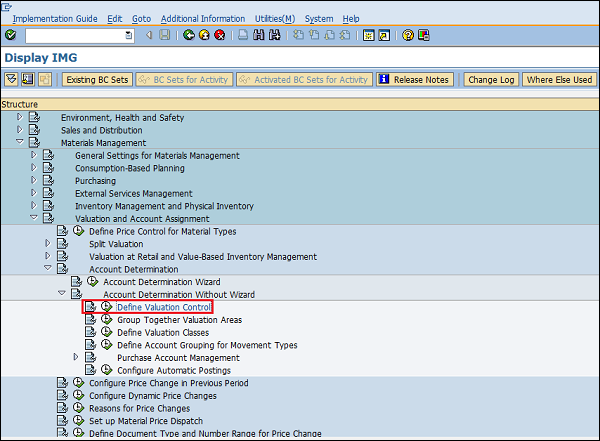
Step 2 − Select Valuation grouping code. Click on Save. Valuation grouping code is now activated.
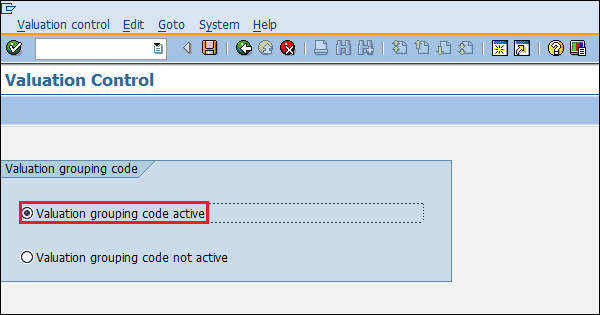
Group Together Valuation Areas
In valuation grouping, valuation area and valuation grouping code are assigned to the company code. This can be done by following the below steps.
Path to Define Valuation Area and Valuation Grouping Code
IMG ⇒ Materials Management ⇒ Valuation and Account Assignment ⇒ Account Determination ⇒ Account Determination without Wizard ⇒ Group Together Valuation Areas
TCode: OMWD
Step 1 − On the Display IMG screen, select Group Together Valuation Areas by following the above path.
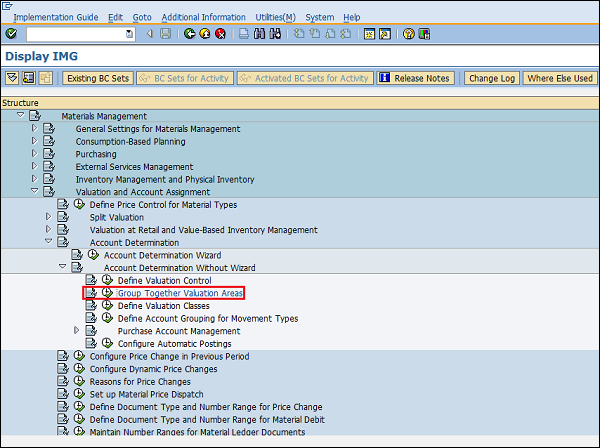
Step 2 − Here you can define a valuation area with grouping code, and assign them to a company code. Click on Save. Valuation area and valuation grouping code are now defined for a company code.
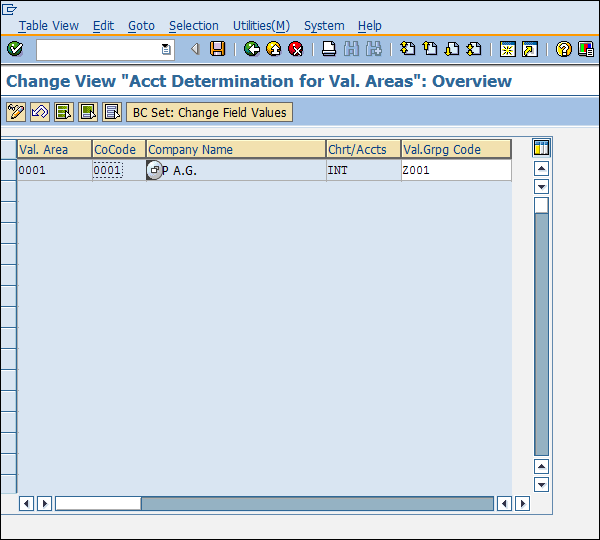
Valuation class categorizes the G/L account on the basis of material type. For example, raw material will have different G/L account than the finished material, as the costs will be different in both the cases. Account reference is also maintained along with the valuation class. Account reference and valuation class can be defined by following the steps given below.
Path to Define Account Reference and Valuation Class
IMG ⇒ Materials Management ⇒ Valuation and Account Assignment ⇒ Account Determination ⇒ Account Determination without Wizard ⇒ Define Valuation Classes
TCode: OMSK
Step 1 − On the Display IMG screen, select Define Valuation Classes by following the above path.
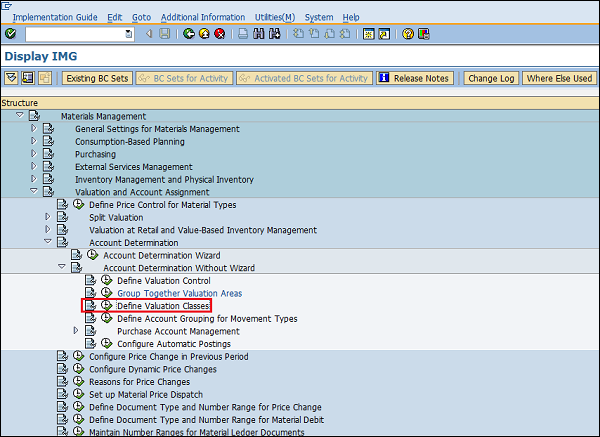
Step 2 − Click the Account Category Reference button.
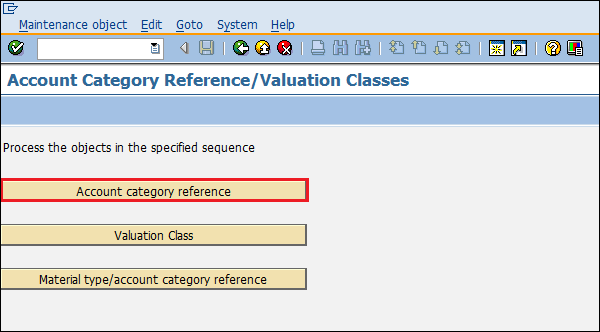
Step 3 − Click New Entries.
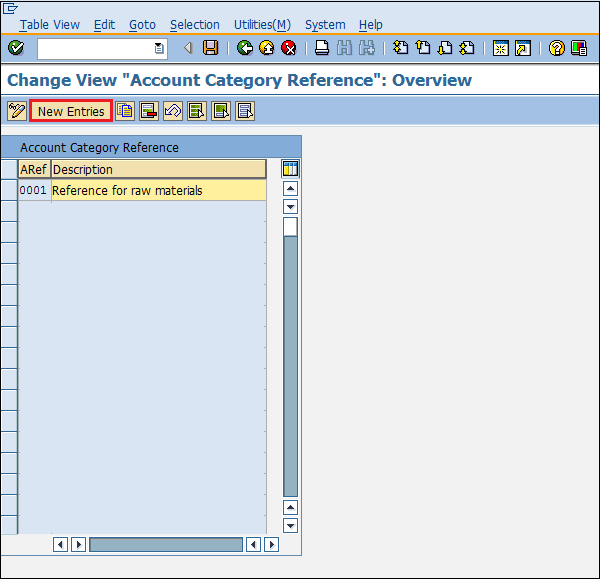
Step 4 − Provide the name of ARef (Account reference) along with its description.
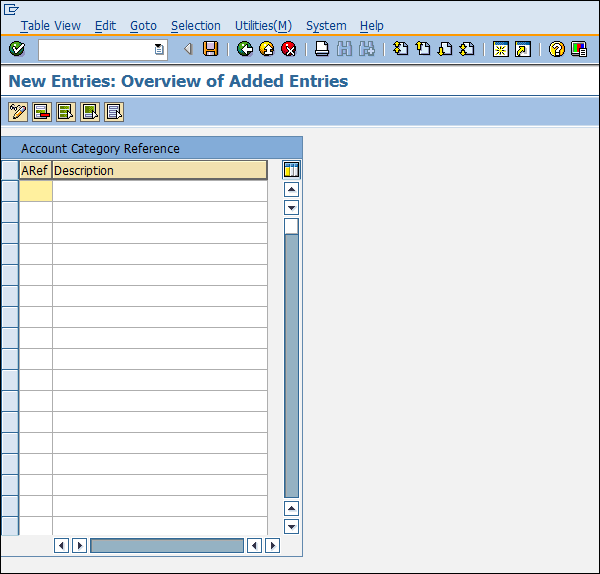
Step 5 − Now go to same screen and click Valuation Class.
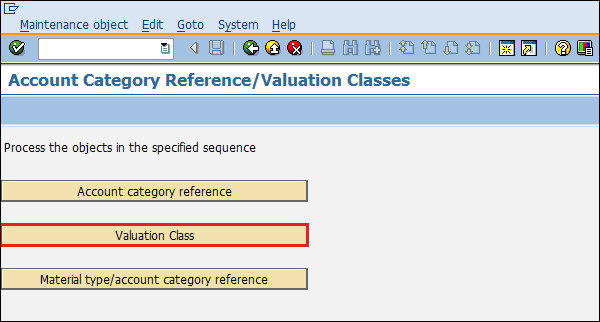
Step 6 − Click New Entries.
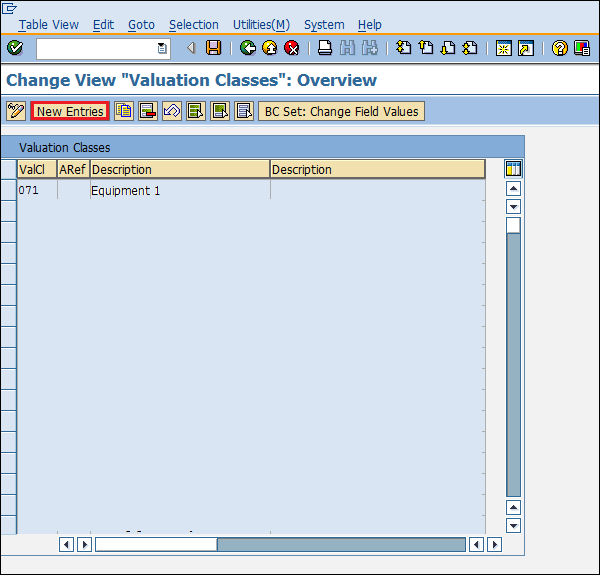
Step 7 − Provide the name of valuation class, ARef (Account reference), and description of valuation class.
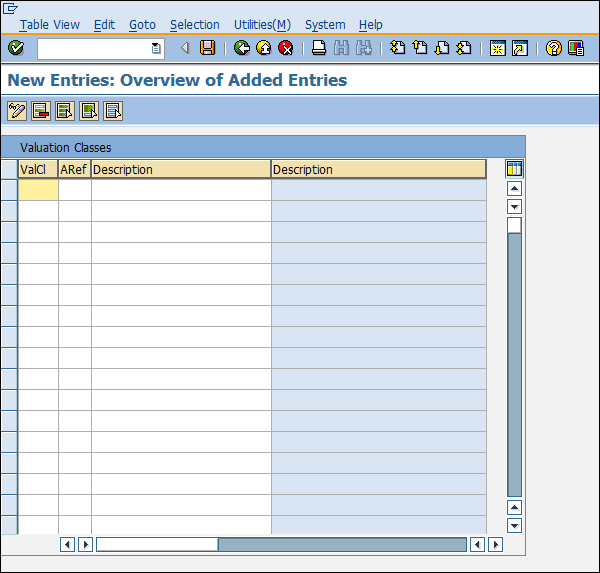
Step 8 − Now go to the same screen and click Material Type/Account Category Reference.
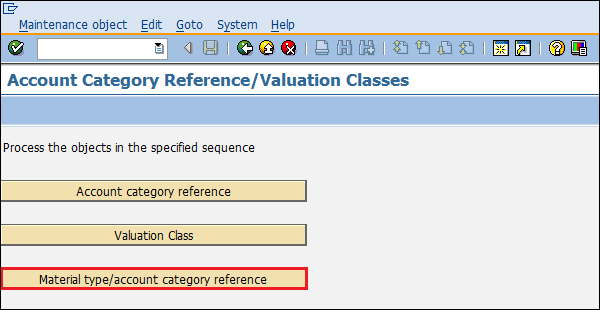
Step 9 − Here you can map material type with ARef (Account reference). Click on Save. G/L account can now be posted for different material types.
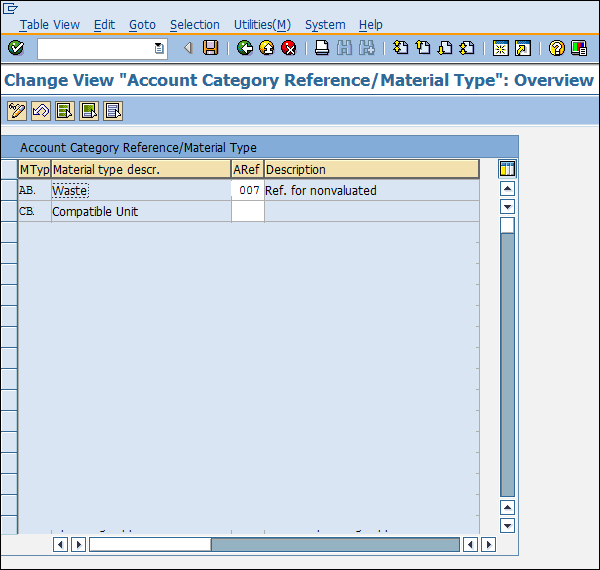
G/L account is automatically determined for each of the transactions. It happens so because automatic postings are configured in the SAP system. Automatic posting can be configured by following the steps given below.
Path to Configure Automatic Posting
IMG ⇒ Materials Management ⇒ Valuation and Account Assignment ⇒ Account Determination ⇒ Account Determination without Wizard ⇒ Configure Automatic Postings
TCode: OMWB
Step 1 − On the Display IMG screen, select Configure Automatic Postings by following the above path.
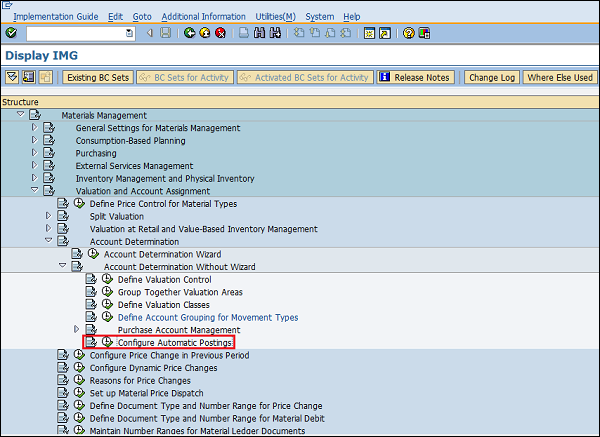
Step 2 − Click Account Assignment.
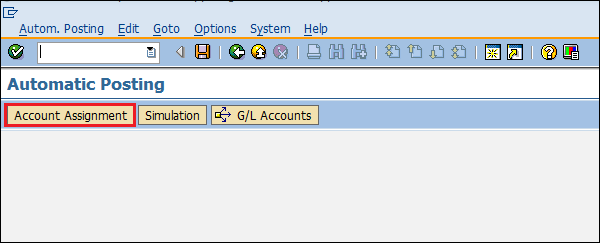
Step 3 − Here you can maintain the transaction for which automatic account determination is there. Click on Save. Automatic posting for transactions is now configured.
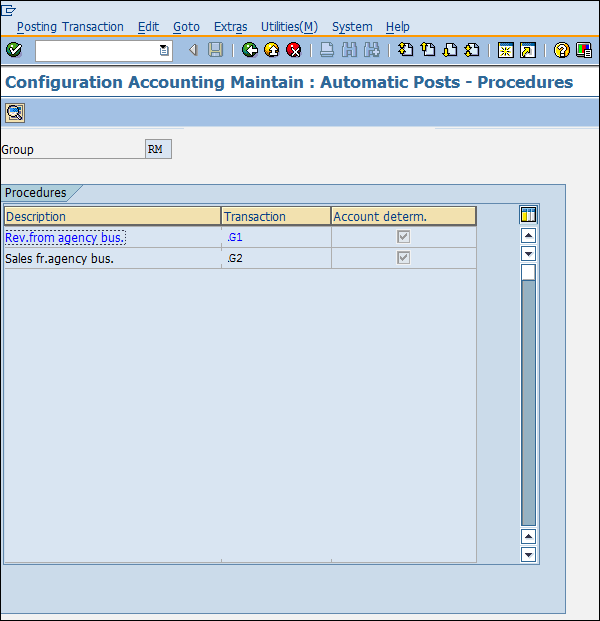
Account Assignment Categories and Document Types for PR in SAP
How to assign categories and document types for purchase requisition.
The following training tutorials guide how to assign account categories and document types for PR. You can assign categories and document types for PR by using one of the following navigation methods.
- SAP IMG Path : – Project system >> material >> procurement >> Account Assignment Categories and Document Types for Purchase Requisitions
- Transaction code: – OPS8
Refer below step by step procedure to assign account assignment categories to document types for purchase requisition in SAP.
Step 1: – Enter transaction code “OPS8” in the SAP command field and press enter key.
Step 2: – On material flow in the network overview screen, click on new entries to assign categories and document types
Step 3: – On new entries of the Account assignment screen, update the following fields.
- Procurement: – Update the three digits alpha-numeric id that identifies the procurement indicator and updates the descriptive text.
- Priorities: – Priorities control various stock types, for example, you can set priority project to 1, priority plant to 2, and priority sales to 3.
- Control data: – Control data control the purchase requisition network, third-party material is delivered to customers, and preliminary purchase requisitions.
- Default item category: – Update the default item category for the item category MRP (Material Requirement Planning)
After maintaining the required details Account Assignment Categories and Document Types for PR Click on the save button to save the configured data.
Continue to read SAP PS Tutorial with real-time scenarios.

IMAGES
VIDEO
COMMENTS
Account Assignment Category: It indicates what type of purchase the company is doing in Purchasing Documents, whether it is for consumption or anything relation to orders, projects etc. The nature of this also indicates which accounts it needs to be charged for when the incoming invoice and Goods Receipt are posted. Path.
Use. You can assign one or more account assignments to an item. Multiple account assignment allows you to apportion the costs covered by a purchase order partly to your own cost center and partly to others, for example. You specify which account assignment object is to be charged via the account assignment category. Account Assignment Category.
Learn how to configure and use account assignment categories in SAP S/4HANA on-premise. This document provides step-by-step instructions for creating, modifying, and deleting account assignment categories, as well as defining the relevant settings for account assignment objects, G/L accounts, and item categories.
Basics of Item categories and account assignment categories in SAP MM
Solution: The indicator determines which account assignment screen is used by default for maintaining the account assign. for a purchase orde r item. For the EnjoySAP transactions, this value is simply a proposal that you can change in the purchasing document. For the old transactions, this value is the only one that you can use.
#sap #mm #accountassignment #mmaccount #course #sapcourse #sapmmcontent #sapmmsyllabus #syllabus #sapconfiguration #mm #sapmm #sapmmconfiguration #sapmmconsu...
Account assignment in SAP MM: Account Assignment category is a very relevant field available and utilized in the purchasing documents. It has various control functions and assists in managing the objects (e.g. sales order, cost center, project) that are charged within the case of a purchase order for material that is meant for direct usage or ...
In the item section of the SAP blanket purchase order, enter the following details: Select account assignment category K - Cost center to denote that a cost center should be specified and that all invoices should be charged to that cost center. The account assignment category list may contain standard and customized categories.
Use. You can assign one or more account assignments to an item. Multiple account assignment allows you to apportion the costs covered by a purchase order partly to your own cost center and partly to others, for example. You specify which account assignment object is to be charged via the account assignment category. Account Assignment Category.
The account assignment category determines: The nature of the account assignment (cost center, sales order, and so on) Which accounts are to be charged when the incoming invoice or goods receipt is posted. Which account assignment data you must provide. Account Assignment Categories. Description. Required account assignment data.
#sap #agisesap #SAPMM#Procurement#AccountAssignment#ItemCategories#MaterialManagement#SAPTraining#SupplyChain#BusinessProcess#SAPBusiness#MMModule#FinancialT...
Type in Table T030 and press Enter to display the selection screen shown in Figure 1. Figure 1: Table T030 Selection Screen To Display SAP MM-FI Configuration Settings. You restrict the table entries displayed on the subsequent results screen by making entries in the Selection Criteria section. To display G/L accounts posted during goods issues ...
Account Assignment category is one of the very important fields available and used in the purchasing documents. It has many control functions and helps in determining the objects (e.g. cost center, sales order, project) that are charged in the case of a purchase order for a material that is intended for direct usage or consumption.
Step 1 − On the Display IMG screen, select Configure Automatic Postings by following the above path. Step 2 − Click Account Assignment. Step 3 − Here you can maintain the transaction for which automatic account determination is there. Click on Save. Automatic posting for transactions is now configured.
Step 1: - Enter transaction code "OPS8" in the SAP command field and press enter key. Step 2: - On material flow in the network overview screen, click on new entries to assign categories and document types. Step 3: - On new entries of the Account assignment screen, update the following fields. Procurement: - Update the three digits ...
A grouping of all the attributes that are available for templates of the following template categories: Settlement account Securities position account Customer position account G/L account. Account Category in SAP - Everything you need to know about Account Category; definition, explanation, tcodes, tables, wiki, relevant SAP documents, PDFs ...